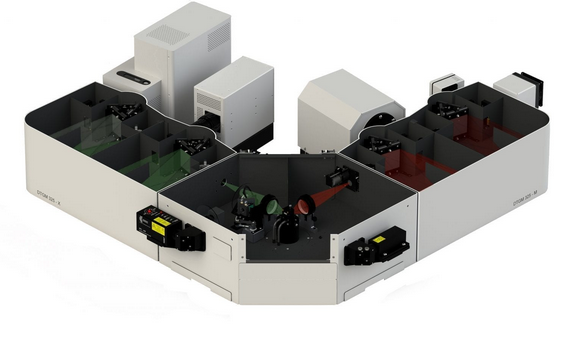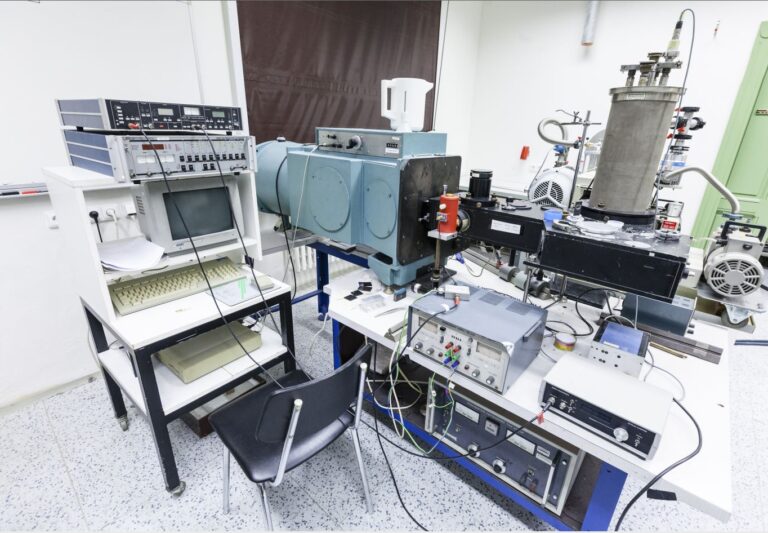Optical spectroscopy
Head of the laboratory: Zdeněk Bryknar
Staff: Zdeněk Potůček, Kateřina Aubrechtová Dragounová
PhD students:Amayes Gaston-Bellegarde, Oleksandr Oleksandrovich Lopata, Juraj Sládek
- Fields of research
- Main experimental equipment
- Researched projects
Fields of research
The research activity of the laboratory is focused on optical diagnostics of bulk and thin film dielectric materials. The crystalline and ceramic materials that are investigated are suitable for applications such as optoelectronics, lasers, thermoluminescence detectors and scintillators for ionizing radiation. The aim of our research is to elucidate the electronic structure, formation and properties of point defects and impurity properties in the materials studied. The results of the research are used to optimize crystal growth, to prepare ceramics and thin films, and to control the content of some impurities in manufactured materials.
Činnost laboratoře je zaměřena na optickou diagnostiku objemových a tenkovrstvých dielektrických a polovodičových materiálů. Cílem studia je pomocí luminiscenční, absorpční a Ramanovy spektroskopie objasnit elektronovou strukturu, tvorbu a vlastnosti bodových poruch a nečistot ve zkoumaných materiálech ve vztahu k jejich struktuře.





Fields of research
The research activity of the laboratory is focused on optical diagnostics of bulk and thin film dielectric materials. The crystalline and ceramic materials that are investigated are suitable for applications such as optoelectronics, lasers, thermoluminescence detectors and scintillators for ionizing radiation. The aim of our research is to elucidate the electronic structure, formation and properties of point defects and impurity properties in the materials studied. The results of the research are used to optimize crystal growth, to prepare ceramics and thin films, and to control the content of some impurities in manufactured materials.
The laboratory disposes of four apparatuses for the study of photoluminescence properties of solids, which are equipped with detectors that allow to register extremely low light intensities in the spectral region of 300 - 4000 nm. In addition to the measurement of emission and excitation spectra of photoluminescence, this equipment also allows the study of photoluminescence decay, thermoluminescence, radioluminescence, X-ray luminescence and optical absorption of materials. Thanks to helium optical cryostats, these measurements can be made at temperatures of 4.2 to 450 K. In addition, a micro-Raman spectrometer with a confocal microscope is available which allows the spatial variation of Raman scattering and photoluminescence emission spectra to be investigated in bulk samples.
Main experimental equipment
Commercial photoluminescence spectrometer FLS1000
The spectrometer allows the following luminescence characteristics of samples to be measured at room temperature:
- Emission spectra in the region 200 - 980 nm when excited with monochromatic light from a high-pressure xenon lamp,
- excitation spectra in the region 200 to 1000 nm for emission in the region 200 to 980 nm,
- photoluminescence lifetime from 200 ps to 1 s with emission in the 200 - 980 nm region, when excited with a pulsed "microsecond" xenon lamp usable in the 200 - 1000 nm region, a pulsed "nanosecond" hydrogen lamp usable in the 200 - 400 nm spectral region, or pulsed "picosecond" diode lasers (445, 510, 635, 670 nm),
- time-resolved emission spectra with selectable delay times,
- absolute quantum yield of photoluminescence in the 250 - 980 nm region,
- spectral dependence of the optical density or transmission of the sample in the region 200 - 1 000 nm,
- the chromatic coordinates of the photoluminescence of the sample according to the CIE 1931 and CIE 1976 standards.

Modular apparatus for measurement of luminescence characteristics with high detection sensitivity by photon counting
The apparatus allows to measure the following luminescence characteristics of samples at temperatures from 10 to 370 K:
- Emission spectra including measurements in polarized light in the range 300 - 1 150 nm when excited by Ar-Kr laser and He-Cd laser lines, laser diodes (375, 405, 685, 808, 975 nm), or monochromatic light from a high-pressure xenon or deuterium lamp,
- excitation spectra including measurements in polarised light in the 200-600 nm region for emission in the 300 - 1150 nm region,
- measurement of the azimuthal dependence of the degree of polarisation of luminescence by the rotating crystal method,
- measurements of thermoluminescence curves after exposure of the sample to monochromatic light from a high-pressure xenon or mercury lamp, or X-rays.

Apparatus for measuring excitation spectra of photoluminescence in the infrared region of the spectrum using synchronous detection method
The apparatus allows the measurement of excitation spectra over a wide range of 200 – 2 500 nm for emission from spectral region of 800 – 4 000 nm at liquid helium, liquid nitrogen and room temperature. The spectral region of the sample emission registered by the semiconductor detector (Ge, PbS, InAs) is separated by interference or edge filters..

Apparatus for measuring photoluminescence emission spectra in the infrared region of the spectrum using synchronous detection methods
The apparatus allows the measurement of emission spectra in the spectral region 800 - 4 000 nm at temperatures from 4 to 370 K and excitation by lines of Ar-Kr laser, He-Cd laser or laser diodes (375, 405, 685, 808, 975 nm), or monochromatic light of high-pressure xenon or mercury lamp. The emission of the samples is registered by semiconductor detectors (Ge, PbS, InAs). The apparatus can be evacuated, thus eliminating the influence of air absorption on the measured spectra.

Micro-Raman spectrometer LabRAM HR Evolution with confocal microscope
The-1 spectrometer enables fully automated 3D investigation of Raman scattering spectra in the range from 150 to 4 000 cm-1 and luminescence emission spectra in the spectral region 330 – 1 550 nm. The sample can be excited at wavelengths of 325 nm (He-Cd laser), 532 nm (Nd:YAG laser) and 633 nm (He-Ne laser). The spatial resolution for the 532 nm wavelength is better than 0.5 μm in the lateral direction and better than 2 μm in the axial direction.

Researched projects
Optical Spectroscopy Laboratory projects supported by grants since 2002, in which Optical Spectroscopy Laboratory staff acted as Principal Investigators (PI) or Co-Investigators (CI):
- 1999-2004: VZ MSM 210000022, Laser systems and their applications, (CI)
- 2000-2002: GAČR 202/00/1425, Spectroscopy and new phenomena in multiply doped materials of the perovskite group, (PI)
- 2002-2005: GAČR 202/02/D072, Optical spectroscopy of doped ferroelectric thin films and crystals, (PI)
- 2005-2007: GAČR 202/05/2233, Nanodiamond thin films: technology, structural and electronic properties and bio-sensors, (CI)
- 2005-2011: VZ MSM 6840770021, Materials Diagnostics, (CI)
- 2008-2010: GAČR 202/08/1009, Characterization and technology of new perovskite structures, (PI)
- 2010-2012: SGS10/297/OHK/3T/14, Preparation and properties of new dielectric and semiconductor materials and structures promising for applications, (PI)
- 2012-2014: GAČR P108/12/1941, Advanced preparation methods and experimental investigation of doped perovskite thin film systems with high energy storage density, (PI)
- 2013-2015: SGS10/218/OHK/3T/14, Preparation and properties of new dielectric and semiconductor materials and structures promising for applications, (PI)
- 2016-2018: SGS10/244/OHK/3T/14, Preparation and properties of new dielectric and semiconductor materials and structures promising for applications, (PI)
- 2018-2023: CAAS CZ.02.1.01/0.0/0.0/16_019/0000778, LASE-Opticaly spectroscopy, (CI)
- 2019-2021: SGS10/188/OHK/3T/14, Preparation and properties of new dielectric and semiconductor materials and structures promising for applications, (PI)
- 2022-2024: SGS10/182/OHK/3T/14, Preparation and properties of new dielectric and semiconductor materials and structures promising for applications, (PI)
A number of research projects were carried out in cooperation with foreign and domestic institutions, e.g.: The Fritz-Haber-Institute of the Max-Planck-Society in Berlin, the Technical University in Berlin, Universität Giessen and a number of laboratories at the Institute of Physics of the CAS.